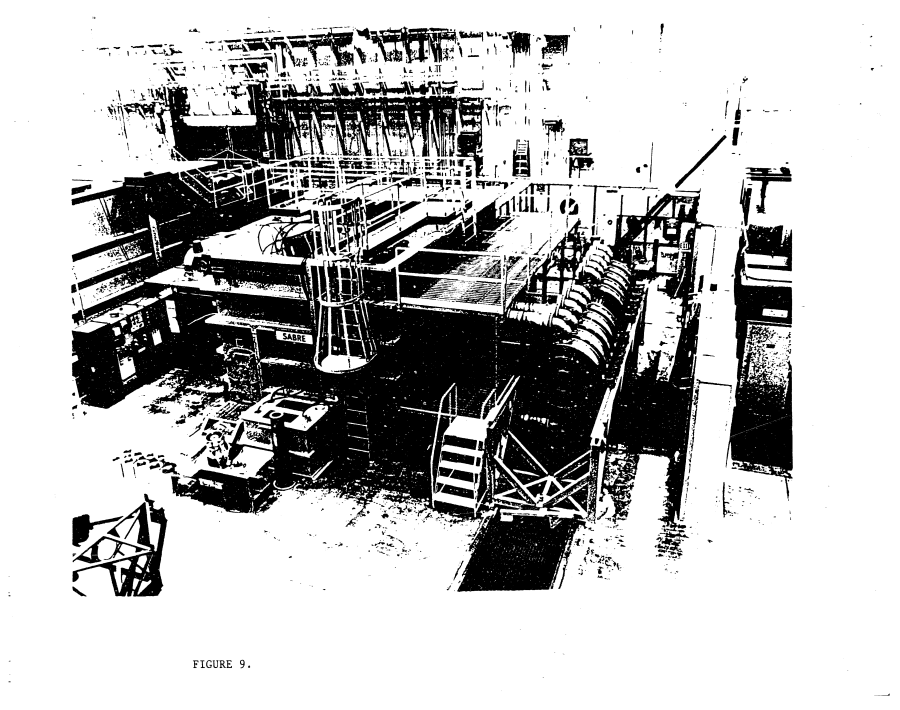|
SABRE (Sandia Accelerator And Beam Research Experiment) Ion Beam Generator |
| SABRE Light Ion-beam Generator
Lithium ion beam divergence on SABRE extraction ion
diodeexperiments  Hanson, D.L.; Cuneo, M.E.; Johnson, D.J.; Wenger, D.F.;
Welch, D.R.; Mehlhorn, T.A.; Johnston, R.R.; Armijo, J.; Nielson, D.
- Plasma Science, 1998. 25th Anniversary. IEEE Conference
Record - Abstracts. 1998 IEEE International on
Summary: Summary form only given. Intense lithium beams are of particular interest for
light ion inertial confinement fusion applications because lithium ions
can be accelerated at high voltage in a single charge state (Li+) with
a high mass-to-charge ratio and appropriate range for efficient focusing
and heating of a hohlraum ICF target. Scaling to ion power densities adequate
to drive high gain pellet implosions (600 TW at 30 MeV) will require a
large number of beams transported, temporally bunched, and focused onto
a target, with the necessary target standoff to ensure survival of the
driver modules. For efficient long distance transport and focusing to a
small pellet, lithium beam divergence must be reduced to about 12 mrad
or less (depending on the transport scheme). To support the eventual development
of a light ion driver module for ICF applications, we are currently working
to improve the composition, uniformity, and divergence of lithium ion beams
produced by both passive LiF and active laser-generated lithium ion sources
on extraction applied-B ion diodes on the SABRE accelerator (1 TW, 5 MV,
250 kA). We will report on the operation of this lithium beam divergence
diagnostic and on results of time-resolved divergence measurements in progress
for passive LiF ion sources and laser-produced active lithium sources operated
in diode configurations designed to control divergence growth. Comparisons
will also be made with time-integrated divergence results obtained with
small entrance aperture ultracompact pinhole cameras  PDF FILE: http://ieeexplore.ieee.org/ |
| Ion Source Requirements for
Light Ion Beam Fusion Energy Production
High-current-density, high-energy ion beams are generated in an applied-magnetic-field (applied-B) ion diode coupled to a high-voltage pulsed power accelerator. Beam generation and acceleration are done in one or two short, closely-coupled regions at high accelerating gradients (0.5 - 1 GV/m), well above the threshold for emission of electrons from electrode surfaces. These devices therefore require the use of several-Tesla insulating magnetic fields to restrict electron motion across anode-cathode gaps of order 1 - 3 cm, while accelerating lithium ions to generate ~ 1 kA/cm2, 5 - 15 MeV beams. Electrons drift in the E x B direction, forming a virtual-cathode electron sheath. |
| Related Links: A LIGHT ION BEAM DRIVER FOR THE LABORATORY Papers: |
| FAIR USE NOTICE: This page contains copyrighted material the use of which has not been specifically authorized by the copyright owner. Pegasus Research Consortium distributes this material without profit to those who have expressed a prior interest in receiving the included information for research and educational purposes. We believe this constitutes a fair use of any such copyrighted material as provided for in 17 U.S.C § 107. If you wish to use copyrighted material from this site for purposes of your own that go beyond fair use, you must obtain permission from the copyright owner. |
|
|
